|
On a trip to... the movies! By Gerhard den Hollander and Brian "_pink" Davis _pink: Welcome back RoIO Review readers! In this issue of Spare Bricks, we take a trip into the theater with the Floyds and check out some of the more obscure works that may not have surfaced on studio releases! Before we get into the Review for this issue Gerhard and I would like to announce the winners of the "I wanna guest host RoIO Review!" contest! Drum-roll please... From my side of the pond we have Sean Zloch <zloch@mediaone.net> whom I've traded with before and know firsthand that he has quite some knowledge about RoIOs, and he's got a cool last name too! From Ger's side of the globe we have Steven Van Impe <amelagar@orisis.net> who sure knows how to write an essay! Thanks for the kind words, Steven. So in the next issue of Spare Bricks, Sean, Steven, Ger and I will take on the monumental task of Reviewing the SUPREME RoIO of all Floyd-dom... Total Eclipse! Yep folks... All 4 CD's. Congratulations, guys!!!
"Interstellar Overdrive"
Gerhard: And in this issue we will have a listen to some of the stuff Pink Floyd
has made especially for film. First we have "Interstellar Overdrive"
from San Francisco. Also known as the Fast version. The soundtrack
to 15 minutes of film on fast forward, snaps, bits and clicks (and, oddly
enough, the Guggenheim Museum in NY) that are meant to depict a day in
the life of San Francisco, set to the music of "Interstellar Overdrive".
A rather exciting and fast version. A joy to hear. _pink: Yes it's rather 'raw' as compared to the released version but I kind of like it that way. Next we have "Interstellar Overdrive" from Tonight Let's All Make Love in London. This is THE version of "Interstellar Overdrive" in my opinion, hands down. Just the right amount of lunacy and delirium. What an insanely imaginative group of individuals. "Nick's Boogie" _pink: This is as close to "Interstellar Overdrive" as you'll ever get. This long and rambling piece doesn't provide much incentive to listen to it except for the fact that it's Pink Floyd and you don't listen to it everyday. Gerhard: Yup... that's true... occasionally someone asks me why "Nick's Boogie" was never released by Pink Floyd, and I usually reply with "You obviously haven't heard it yet then?'' Both these tracks ("Interstellar Overdrive" and "Nick's Boogie") are from the Pink Floyd 1966-1967 release (now official). The only reason we list them in this review is: a) they are on many, many, many roios and b) they are excellent songs (in my opinion at least). If you like early Floyd, these two songs are essential and required listening. [Note: "early Floyd" means Syd's Floyd (i.e 1966-1967) in my book. Don't get confused with other people who refer to the pre-1987 Pink Floyd as "early".] The Committee Gerhard: For this movie the Floyd recorded about 15 minutes of work (the full story is available elsewhere in this issue), which is only of interest for the real fanatics and historians. It does contain the earliest known version of "Careful With That Axe, Eugene", and about 12 minutes more of aimless noodling going nowhere. _pink: Yes, this is 'interesting' to say the least. There is one segment after
"Careful With That Axe, Eugene" that is a guitar based piece that
I jokingly call "The bus drives off" because it does... right
in the start of the song, a bus drives off... I really think it could
have been a neat piece to hear in its entirety.
Gerhard: Yes. That sentiment ("I really think it could have been a neat piece
to hear in its entirety...") is true for most pieces we are discussing
here.
More:
(Alternate/Unreleased tracks from the movie)
"Seabirds"
Gerhard: The lyrics to "Seabirds" have been published in a music book, and were
my first introduction to this song. Upon reading the lyrics I was expecting
a nice mellow song (kind of like "The Crying Song".) Much to my surprise
(a pleasant surprise indeed) this song is an out-and-out rocker that
puts even "The Nile Song" to shame. _pink: I absolutely would die to hear this in its pure form. It is an absolute
sin that "Seabirds" wasn't released in any other form than this.
Gerhard: And for your reading pleasure... the lyrics to "Seabirds"
"Cymbaline" Gerhard: The film version is a more raw version of this classic, with slightly different lyrics. _pink: Yeah, it's a little more upbeat and the bongos are nice. "Hollywood"
Gerhard: A whopping 21 seconds of this can be found on the movie soundtrack.
It took a lot of listening to find it. Even knowing where it is, you
will easily miss it. An understandable omission from the released LP.
Zabriskie Point : "Heart
Beat, Pig Meat" _pink: An interesting tune to say the least. Mostly comprised of Nick drumming and Rick playing around on the keys while voice clips (some from the movie) are intertwined throughout. "Crumbling Land" _pink: This is actually one of my favorite Floyd tunes. Kind of reminds me of The Grateful Dead and it's very possible that the Floyd could've been swayed a little as Jerry and the Dead also worked on this soundtrack. "Come In Number 51, Your Time Is Up" _pink: By far, hands down my most favorite rendition of this song. The film footage is absolutely incredible and Rog's screaming fits perfectly. Man, it doesn't get any better than this.
Gerhard: Well ... "Come In Number 51" is, as I guess we all know, a remake of "Careful
With That Axe, Eugene" (and probably the reason Pink Floyd was asked
by Antonioni in the first place).It manages to pack all the punch of
"Careful" in only a few minutes and is an excellent song to end the movie
with a bang. Having said all that, it's nowhere near my favorite version
of "Careful" (though it will probably make my top 10). The versions from
Boeblingen (on the Jemig de Pemig RoIO), Toronto (Yeeshkull RoIO,
reviewed here) and Oakland 1977 (during the Animals tour; many RoIOs
have this) are hands down much better (in my opinion of course). _pink: The Pink Floyd did many songs for Zabriskie Point but only the above were put on the soundtrack. I have decided to share my thoughts about those that didn't make it. "Country Song" _pink: Finally released on the re-release of the Zabriskie Point soundtrack this quaint tune is a most welcome addition to the Floyd catalogue. Why it was cut from the soundtrack I'll never know. I guess that's why I'm not making movies and such. "Unknown Song" ("Rain in the Country" [alternate version]) _pink: A fair enough song. If you smoke enough of it it'll get you high. Uh...I mean if you listen to enough it'll... uh, make you... make you feel like you've uh... like listened to somethin'... Uh, guys..... Ger? What? Why are you lookin' at me like that? Do we have any chips left? [Editor's note: I don't know these guys.] "Love Scene version 6" _pink: Dave and some nasty butt-smackin' blues. What more can I say? "Love Scene version 4" _pink: A nice and soothing piano piece from Rick. Very nice indeed.
Gerhard: 'Very nice indeed'? Well, tastes differ... I'm not much a fan of Rick's
solo piano noodlings. It's tiresome, meandering, and very close to utter
boredom, but then, so are large portions of the movie. So in that aspect,
this song is perfectly suited for the movie... even if it was never
used.
"Oneone"/"Fingal's
Cave" _pink: This is the 'cup' that rests on the 'saucerful of secrets'.
Gerhard: "Oenone" is a long and (at times) interesting instrumental, and yet at the
point where you think it has been going for too long it merges into
"Fingal's Cave", an up-tempo, all-out rocking instrumental that blows
you back into your seat again. Delicious!
"Rain
in the Country" _pink: A different take from the above mentioned "Unknown Song". A bit rawer and with bongos. "Echoes" (from Crystal Voyager)
Gerhard: The movie Crystal Voyager was a surf movie. The last 25 minutes
of the movie feature recordings of a surfer rolling through the waves,
made with a camera set on the surfboard itself. Those 25 minutes have
been set to the music of "Echoes", the LP version. It works pretty well,
but so does putting on the evening news, turning off the sound and putting
Atom Heart Mother on the stereo. And if you put your record player
on repeat, you can watch TV all night to the tunes of Atom
Heart Mother.
The
Wall film soundtrack
"The
Little Boy That Santa Claus Forgot" _pink: Although not actually a Floyd tune, Vera Lynn provides a wonderful and delightful wartime classic. "When the Tigers Broke Free" (in the movie split into 2 parts) _pink: When I first heard this tune I thought to myself, 'Wow, what a dim and gloomy way to remember one's father', and then I remembered that Rog wrote this.
Gerhard: This song alone is worth getting the DVD version. For years this song
was only available as a single to promote the movie (and going for insane
amounts of money at record shows). Then Roger did The Wall in
Berlin, and the song was released on a sampler CD (which was also very
hard to get and very expensive), but this led to the appearance of this
track on a large variety of RoIOs. If you've never heard this song yet,
put it on the top of your "must track down" songs.
La
Carrera Panamericana - "Pan Am Shuffle" - "Country Theme" - "Mexico '78" - "Big Theme" - "Small Theme"
Gerhard: Years ago, around Christmas, I noticed in the TV guide that the BBC was going
to present a one hour program, with new music by Pink Floyd. I freaked,
I flipped, and I couldn't believe it. Anticipation... And then the program
started, and utter and total boredom struck. La Carrera Panamericana is a 60 minute movie about Dave and Nick (and Steve O'Rourke) racing
cars in Mexico, set to the sound of (you guessed it) racing cars. There
are also some remakes of Pink Floyd tunes, and some new and original
Floyd material which is only interesting because it gives credit to
all 3 of them (Mason, Wright, and Gilmour) which hasn't happened ever
before, except for "Any Colour You Like". Apart from that, the music is
even less interesting than the soundtrack to The Committee. _pink: While the music isn't the main focus of this movie I did find it rather interesting that this is the ONLY Pink Floyd related item that my dad and I have enjoyed together. He's into cars and the music wasn't out of place or the main focus. Enough said. The Hit film soundtrack
Gerhard: Roger plays on a 3 minute instrumental featuring Eric Clapton, proving
that it's not just Gilmour, Mason, and Wright who can make uninspired
and boring movie music. At 3 minutes this ditty however bears repeated
listening. So to summarize it all... There are often complaints about
the fact that all the movie-related Floyd music is never officially
released. Based on the above I can see that there is some validity in
the Floyd's statements that what wasn't released wasn't good enough
for public consumption. However (on the off chance that someone who
has any say in this is actually reading our magazine), this is not true,
all of the above (even The Committee music and the La Carrera bits) deserve to be heard and judged on their own merit. We based our
reviews on the versions that we could get our hands on, buried under
layers of movie noise, generational hiss, and other artifacts. _pink: If you look at it logically, the music made for film scores is supposed
to enhance the environment of the images, not overwhelm it. I believe
that there are some of us who would desperately love to listen to all
of the music created for film by Pink Floyd in its pure form. I personally enjoy
listening to the music and gaining a sense of progression of the band.
It's nice to see how each and every note, song, lyric, idea, or anything
can shape the next big 'sound' that a band makes. After all, even these
music scores helped to create the band we all love. My personal plea
is that if there is someone out there reading this who has some connection
or jurisdiction over the materials listed above, please consider just
for once releasing it for public consumption.
That's all for this issue
folks but remember that next issue our two guest hosts will help us
dissect "Total Eclipse" from the start of disc 1 to the end
of disc 4. And as always feel free to send us your love letters, hate
mail, comments, suggestions or whatever to roio-review@ibm.net and we'll see you next time. Until
then, Peace, If you would like to see more information on RoIOs feel free to check out http://www.pf-roio.de/ Gerhard den Hollander and Brian "_pink" Davis are staff writers for Spare Bricks and are not usually allowed to stay out after dark.
The Camera Eye More great moments from Roger Waters' 1999 In The Flesh tour. By Richard Mahon NOTE: The following concert videos are being graded as a guide to documenting the live performance history of Pink Floyd and Roger Waters. In this issue, we continue reviewing videos from Roger Waters' 1999 In The Flesh tour. Roger Waters-PNC Arts Center, Holmdel, New Jersey, August 6, 1999
Roger Waters-Oakdale Theater, Wallingford, Connecticut, August 8, 1999 Roger Waters-Jerome Schottenstein Center, Columbus, Ohio 8/15/99 Roger Waters-Jerome Schottenstein Center, Columbus, Ohio 8/15/99 VIDEO
QUALITY RATINGS
Richard Mahon is a staff writer for Spare Bricks. A rare glimpse of early Pink Floyd Nobody works a gong like Roger Waters, and Stamping Ground proves it By Johnny Valenzuela
The copy I own is from Japan's Superstar Series, which appears to be a knock-off of the American version, as the opening dialog is in English, and the Soft Machine performance is not included (apparently, Soft Machine only made the British version). So the film starts off with this short introduction about American pioneers and how they set out across uncharted territory in their covered wagons, and would stop occasionally, circle the wagons, and set up camp for a couple of days. While set up, they'd play music, dance, sing, and enjoy a few days of united community. This camp was referred to as the "stamping ground". While it all makes sense now, it seemed a bit odd to be watching a Japanese video of a Dutch festival that is based on American folklore. From there, we travel to Holland and the meat of the film begins. Again, the only indication of what festival this is are the words "Holland Music Festival" which are flashed across the screen at the beginning of the film. No real indication of the year or location or occasion is given, which kind of bugged me. But whatever, this film's about the performances; where, when, and why they happened apparently isn't important to the producers. Stamping Ground is edited to give the appearance of a two-day festival, when in reality, according to Vernon, it was three. And the most unusual thing I noticed about the audience is that they were sitting down a lot of the time. This simply would not happen these days. No, these days moshing, crowd surfing, etc usually dominate the front 30 yards of a festival crowd. Damn shame if you ask me, because it sure looked like the Stamping Ground crowd was enjoying themselves as much as anyone. Also, a very cool thing the festival organizers did was to float a bunch of inflatable pyramids in the adjacent lake. We'll get to those a little later. Day one starts with Santana. They were great, but then I love Santana. They will always be great to me. Next, Al Stewart. Hmmm. Interesting. Had a bit of the solo acoustic, songwriter-with-a-cause kind of vibe. Canned Heat. Wow, they really ripped the place up good. And they got two songs in the film. Obviously, this band went over well. T. Rex acoustic, well, ok, fine, whatever. Jefferson Airplane was about as good as they could be. It's A Beautiful Day seemed to have a good performance, but it started raining and apparently didn't let up for the rest of their set. Then comes Family. OK, I think I missed something about these guys, because I was not impressed. Country Joe came next. Another singer/songwriter-with-a-cause thing. Very popular in the late 60s and early 70s. Didn't do a lot for me. Dr. John wraps up the first night. Wearing full Mardi Gras regalia--beads, feathers and all--this looked like it was a great way to end the first night, and was probably a lot of fun. Day Two opens with a band called The Flock. Who are these guys? I've never heard of them, but damn if they don't have the coolest horn section around! I loved 'em. The Byrds followed, and were okay, but in the wake of The Flock, I'd be willing to bet that, if I were at the festival, this would have been a good chance to pee and get another beer. Then comes Jefferson Airplane again, and again, they were about as good as they could be. After Airplane, we cut to slow motion and still shots of people at a bonfire. There's some obviously dubbed-in applause, and then an obvious cross fade to a familiar gong sound. Nobody works a gong like Roger Waters. Ah, finally, Pink Floyd. The bonfire footage slowly evolves to the stage and, sure enough, there's Floyd, and they're launching into "Set The Controls For The Heart Of The Sun." But somewhere in the early part of the opening, there is a musical cross fade and suddenly we're in the middle of the song, just after the first verse. The instrumental build-up begins. Well, okay, I guess we don't get the first verse. Bummer. I'd love to hear the whole thing (frankly, I'd love to see all the footage of Floyd's performance). Nick Mason is tearing it up! For anyone who ever said Nick is a weak drummer, I say watch Pompeii and Stamping Ground. Waters is working the big gong vigorously, and Rick Wright is doing his best Turkish Delight stuff on the keys. David Gilmour, unfortunately, hardly appears in the footage at all. In fact, if you didn't know anything about Pink Floyd, during "Set The Controls For The Heart of the Sun" you'd be inclined to think they were a trio. So the band reaching the climactic crescendo, and it's a rousing one at that. The crowd goes crazy. Great stuff. And then, just when you're ready to hear some trippy keys and Roger starting up the familiar riff, suddenly there's more gong. Hmmm. Then, Rick Wright starts up with the "Celestial Voices" portion of "A Saucerful Of Secrets." What? What happened to the rest of "Set The Controls"? Sheesh, I'm enjoying this and all, but the film's really testing my endurance with this one. Okay, so they gave us just one instrumental part of "Set The Controls," and now they're only gonna give us the last part of "Saucerful"? As much as I'm thrilled to have Floyd footage from this, I'm not sure if I like the amount of chopping the editors did to our precious band. So then, as Rick is doing the "Celestial Voices" bit, they cut back to the lake and the floating pyramids. It's at night, and the pyramids have colored panels on each side, and are probably about 6 feet each side. With the slow motion shots of these pyramids and "Celestial Voices" accompanying the footage, and remembering it was 1970, I thought, "wow, how prophetic. I wonder if the Floyd boys knew what kind of role pyramids were to play in their future?" This version of "Celestial Voices", by the way, is stunning, and even though the Floyd performance is basically hacked to death, "Celestial Voices" almost lets you forgive that fact. Hey, don't blame the editing on the band, right? And they finally included some Gilmour shots when he starts singing. Great stuff, and it's apparent that Waters is really digging it. Great facial expressions from him. In fact, when they get near the end of the second round through the chords with Dave singing, Waters mouths to everyone "one more!" So they go 'round the chords again, and it's just pure heaven. When they finally arrive at the final note, they really work it for the grand ending, final crashing chord, arena rock anthem ending that it is. Awesome. The crowd goes wild. After Floyd, we get another round of Santana, and that's the end of it. Roll credits. Opinions? Well, I guess a little Floyd footage is better than none, and given the time period, it's some fairly important footage. Too bad they haven't released the complete performance a la Pink Floyd Live At The Stamping Ground, but knowing how particular the Floyd four are, I doubt that will ever happen. So, we have to be content with what we get from Stamping Ground. That is, some highly chopped-up footage of portions of two Pink Floyd songs, from a performance that was obviously riveting. Do I approve? Does it matter? It a concert film with Pink Floyd footage. Works for me. Johnny Valenzuela is a regular contributor to Spare Bricks. "Profiles" in madness A look at the somewhat obscure (non-Floyd) musical offerings of Nick Mason By Ed Paule
Most of the films the duo scored are obscure and hard to find. One of the least obscure is the 1987 feature-length film White of the Eye, directed by Donald Cammell, and starring David Keith, known for his role as Richard Gere's suicidal best friend Sid Worsley in An Officer and a Gentleman, and Cathy Moriarty, who received an Academy Award nomination for her portrayal of Robert DeNiro's wife Vickie La Motta in 1980's Raging Bull. White of the Eye's co-stars include Alan Rosenberg and Alberta Watson. Alan Rosenberg is best known for his role as Cybill Shepherd's ex-husband Ira in television's sitcom Cybill. Alberta Watson, a veteran of more than twenty films, can currently be seen on television, playing Madeline on the series La Femme Nikita. The film is a psycho-thriller based on the book Mrs. White by Margaret Tracy. The story follows the trail of Joan (Cathy Moriarty), who leaves New York on a meandering journey across the country with her boyfriend Mike (Alan Rosenberg). After six months of close-quarters living on the road, Joan and Mike find themselves in Arizona and with a broken radio; an innocent victim of their latest squabble. Here they meet Paul (David Keith). That's when, according to part-Apache Mike, Paul laid the "white of the eye"--some kind of Apache spell--on her. This bewitching causes Joan to leave Mike for Paul. Soon, Paul and Joan get married and have a daughter, and Mike winds up serving time in prison.
The police have no hard evidence against him; but Paul has no alibi either. Meanwhile, Joan believes Paul is having an affair with Ann (Alberta Watson), one of his clients. Although innocent of adultery, Paul's psychosis reveals itself after Joan finds his hidden stash of body parts. Unknown to Paul, Mike has returned to Arizona after his stint in Attica. Mike comes to Joan's rescue and the ensuing showdown leaves both men dead. The film doesn't actually follow this chronology, though. It begins with one of the serial killings, and the history is revealed with various flashbacks and dialogue. It's a decent film. All the actors portray their roles admirably. A better script and a few plot twists could have made this film into a great edge-of-your-seat suspense thriller. One of the best features of this film is its instrumental score by Mason and Fenn, who do an excellent job in setting the mood for each scene. From murder scenes to lovemaking scenes to runaway-from-that-madman-as-fast-you-can scenes and all scenes in between, each piece of music heightens the viewer's experience. Although the Mason and Fenn material has that distinctive, late-80s, Profiles-like feel to it, all of their music for White of the Eye is new. Nothing was taken from their one and only album Profiles, released in 1985. Besides the original music, the duo also covers the 1967 Booker T. & the MGs hit "Slim Jenkins' Joint." This is very interesting. Why did Mason and Fenn include a cover amongst all their other original work? At this I can only speculate. The guitarist for Booker T. & the MGs was a man named Steve Cropper. During an interview, Syd Barrett once mentioned Steve Cropper as one of his influences. Thus, it is quite possible that Syd and Nick and the rest of the gang, during those early years of Pink Floyd, were fans of that Memphis-based rhythm and blues quartet known as Booker T. & the MGs. Then, 20-years later, Nick could have consciously selected this cover as a nostalgic tribute to those early days. Those early days were also the prime years for Pink Floyd soundtracks. But, any comparison between White of the Eye and More, The Valley, or even Zabriskie Point is difficult to make. A chasm of almost twenty years of filmmaking evolution separates these films. Musically, White of the Eye compares favorably with modern blockbusters, but a poor script and weak plot will keep this film locked in obscurity. Ed Paule is a special contributor to Spare Bricks. |

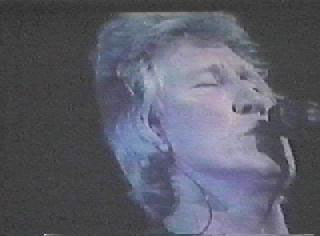 This
video begins with a bit of obstruction and instability. Shot from the
left side of the stage, the camera operator quickly learns the best
shot is the elevated video screen. There are stability and obstruction
problems at the start. The shot of the screen is not as clear as the
Jones Beach video mentioned in last issue's reviews. This screen shot
is a little hazy and slightly tilted. It takes a few minutes before
the shot is settled in on the screen. Then the video becomes very nice,
similar to watching a pro-shot video with slight generation loss. There's
a cut at the start of "It's A Miracle" and "Comfortably
Numb." I grade the video "B" and the audio "VG."
This
video begins with a bit of obstruction and instability. Shot from the
left side of the stage, the camera operator quickly learns the best
shot is the elevated video screen. There are stability and obstruction
problems at the start. The shot of the screen is not as clear as the
Jones Beach video mentioned in last issue's reviews. This screen shot
is a little hazy and slightly tilted. It takes a few minutes before
the shot is settled in on the screen. Then the video becomes very nice,
similar to watching a pro-shot video with slight generation loss. There's
a cut at the start of "It's A Miracle" and "Comfortably
Numb." I grade the video "B" and the audio "VG."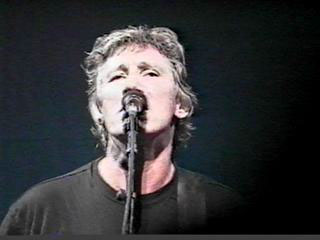 This
video is very close to the stage. Shot from the 7th row, the close-ups
are extraordinary. Unfortunately, there's a lot of obstruction, focus
problems and instability throughout this video. Starting with "Mother"
the video begins to settle in on the best it has to offer--close-ups.
'Hit and miss' is the definitive phrase for this video. You're either
getting an excellent unobstructed close-up or the screen is totally
black due to security ducks and other forms of obstruction. The portions
of the video that are impossible to watch outnumber the close-ups the
camera provides. For this reason, I grade this video "C+." I grade the audio "VG+."
This
video is very close to the stage. Shot from the 7th row, the close-ups
are extraordinary. Unfortunately, there's a lot of obstruction, focus
problems and instability throughout this video. Starting with "Mother"
the video begins to settle in on the best it has to offer--close-ups.
'Hit and miss' is the definitive phrase for this video. You're either
getting an excellent unobstructed close-up or the screen is totally
black due to security ducks and other forms of obstruction. The portions
of the video that are impossible to watch outnumber the close-ups the
camera provides. For this reason, I grade this video "C+." I grade the audio "VG+."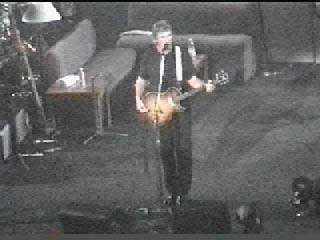 There
were at least four cameras in the Jerome Schottenstein Center in Columbus,
Ohio. This version is the only known video of the complete show that is
not edited or incomplete. This video was shot from the upper balcony
in the back of the arena, towards the right. This location provides
some different shots from the other Waters videos reviewed so far. For
example, the camera angle provides an excellent shot of Hammond organ
player Andy Wallace. In this video, you can see that a Hammond organ
is not present. Wallace is using a Kurzweil keyboard (just as Jon Carin
is) to produce a Hammond organ sound. The camera is steady despite the
distance from the stage and the focus is sharp. Clarity seems to vary.
When the spotlight is on a member of the band the picture is clear.
When the spotlight is off it appears to be somewhat grainy. This is
a well-shot video that I grade "B-" due to the somewhat grainy
picture. Audio is very good for a camcorder - "VG+."
There
were at least four cameras in the Jerome Schottenstein Center in Columbus,
Ohio. This version is the only known video of the complete show that is
not edited or incomplete. This video was shot from the upper balcony
in the back of the arena, towards the right. This location provides
some different shots from the other Waters videos reviewed so far. For
example, the camera angle provides an excellent shot of Hammond organ
player Andy Wallace. In this video, you can see that a Hammond organ
is not present. Wallace is using a Kurzweil keyboard (just as Jon Carin
is) to produce a Hammond organ sound. The camera is steady despite the
distance from the stage and the focus is sharp. Clarity seems to vary.
When the spotlight is on a member of the band the picture is clear.
When the spotlight is off it appears to be somewhat grainy. This is
a well-shot video that I grade "B-" due to the somewhat grainy
picture. Audio is very good for a camcorder - "VG+."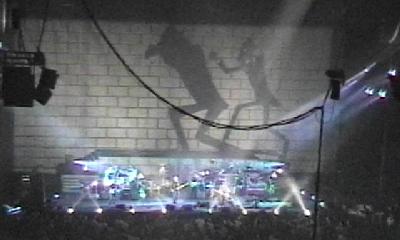 Shot
from the back left corner of the arena, this video features an extraordinarily
clear and unobstructed shot of the background projection screen and
the overall stage setup. The video includes shots of the screen that
do not appear in other videos that focus on the musicians on stage.
The only drawback is a collection of cable wires that stretch across
the screen through the duration of the video. There's a cut in the opener
"In The Flesh". "Get Your Filthy Hands Off My Desert" is completely edited except for the taped introduction. There's another
cut at the end of "Welcome To The Machine" that cuts into
the intro to "Shine On". The show then cuts to the end of
the song. This video only shows the first set of the show but the content
is very nice to watch. I grade this video "B" ("B+" without the wires.) I grade the audio "VG."
Shot
from the back left corner of the arena, this video features an extraordinarily
clear and unobstructed shot of the background projection screen and
the overall stage setup. The video includes shots of the screen that
do not appear in other videos that focus on the musicians on stage.
The only drawback is a collection of cable wires that stretch across
the screen through the duration of the video. There's a cut in the opener
"In The Flesh". "Get Your Filthy Hands Off My Desert" is completely edited except for the taped introduction. There's another
cut at the end of "Welcome To The Machine" that cuts into
the intro to "Shine On". The show then cuts to the end of
the song. This video only shows the first set of the show but the content
is very nice to watch. I grade this video "B" ("B+" without the wires.) I grade the audio "VG."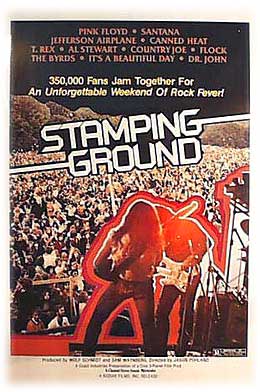 I
want to begin this review with a thanks to Vernon Fitch and the Pink
Floyd Archives, for if it weren't for him, I would know very little
about this film. See, Stamping Ground gives you very little
indication of what festival you're watching. In fact, there's very
little at all in terms of information about the time, the place, the
situation, etc. Unlike its American counterpart film, Woodstock, Stamping
Ground concentrates on the performances, and has very little other
footage. Whether or not this is good or bad is subjective, but nonetheless,
it's a very focused presentation of the Kralingen Pop Festival that
took place in Holland June 26-28, 1970 (again, thank you Vernon).
I
want to begin this review with a thanks to Vernon Fitch and the Pink
Floyd Archives, for if it weren't for him, I would know very little
about this film. See, Stamping Ground gives you very little
indication of what festival you're watching. In fact, there's very
little at all in terms of information about the time, the place, the
situation, etc. Unlike its American counterpart film, Woodstock, Stamping
Ground concentrates on the performances, and has very little other
footage. Whether or not this is good or bad is subjective, but nonetheless,
it's a very focused presentation of the Kralingen Pop Festival that
took place in Holland June 26-28, 1970 (again, thank you Vernon).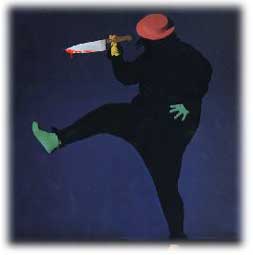 Following
the release of the Profiles album by the duo "Mason +
Fenn," Floyd drummer Nick Mason and 10cc guitarist Rick Fenn
formed Bamboo Music, a company that hoped to specialize in writing
advertising jingles and scoring films. While the team did produce
jingles for several British products, they also scored a few films--including
an unreleased short documentary about Mason's life and race cars entitled
Life Could Be A Dream, which featured film clips of a 1971
Floyd performance.
Following
the release of the Profiles album by the duo "Mason +
Fenn," Floyd drummer Nick Mason and 10cc guitarist Rick Fenn
formed Bamboo Music, a company that hoped to specialize in writing
advertising jingles and scoring films. While the team did produce
jingles for several British products, they also scored a few films--including
an unreleased short documentary about Mason's life and race cars entitled
Life Could Be A Dream, which featured film clips of a 1971
Floyd performance.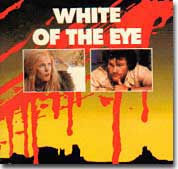 Now,
ten years after his initial radio repair job, Paul works on customizing
stereo components and installing state-of-the-art sound systems for
the well-to-do of the area. This puts him at or near the scenes of
the murders of several rich women. The crimes are linked by dismemberment
of the victims and symbols of Apache rituals.
Now,
ten years after his initial radio repair job, Paul works on customizing
stereo components and installing state-of-the-art sound systems for
the well-to-do of the area. This puts him at or near the scenes of
the murders of several rich women. The crimes are linked by dismemberment
of the victims and symbols of Apache rituals.